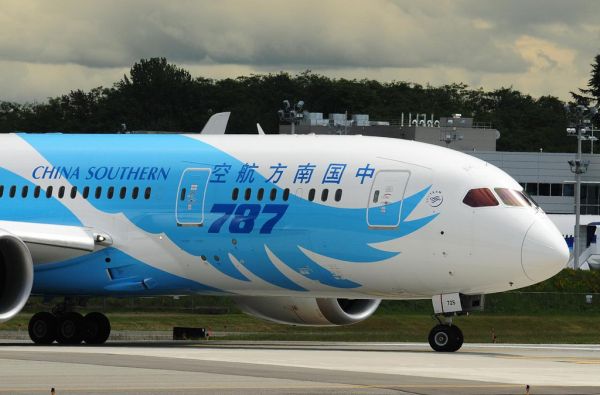


Photo: China Southern's new Boeing 787 Dreamliner. Source: MoonM
By Li Juan (李娟)
Issue 623, June 10, 2013
Corporation, page 27
Translated by Li Meng
Original article: [Chinese]
When China Southern Airlines suddenly cancelled the maiden flight of its new Boeing 787 Dreamliner, it was just the latest of many setbacks its fleet of new modern jumbo jets has experienced in recent years.
The state-owned Guangzhou-based carrier announced the cancellation on the morning of June 6 - the day the flight was scheduled for. It arranged for an Airbus A330 to fly in its place, explaining that Beijing Capital Airport had low visibility and the plane’s pilot was inexperienced with the Dreamliner.
Four days earlier on June 2, China Southern had taken delivery of the Dreamliner in Guangzhou, making it the first carrier in China and the tenth in the world to obtain one. With the plane in its fleet, China Southern is now the only operator in the world flying both Boeing 787 Dreamliner and Airbus 380 aircrafts.
The Dreamliner and A380 are both wide-bodied aircrafts generally used for long-haul flights. As China’s largest carrier by fleet size, China Southern has tried to obtain the newest jumbo jets in recent years in order to boost its global competitiveness. However, operation of the A380 aircrafts has led to massive losses for the airline, and some worry that a new fleet of Dreamliners may just dig the hole deeper.
New Jet
The B787 Dreamliner is the first new jumbo jet model Boeing has introduced since it launched the Boeing 777 in 1994. Marc Allen, president of Boeing China, told the EO that the new model will deliver 15 percent better fuel efficiency.
The Dreamliner is the world’s first mid-sized long-range jet airliner, meaning smaller numbers of passengers can be flown distances previously only reachable by large jets. According to a senior official at China Southern, this will allow the airline to increase international flight destinations and frequencies. Whereas the A380 is better for spoke and hub transport systems, the Dreamliner is regarded as better for high-frequency mid-to-long haul direct flights. China Southern hopes that the two models will complement each other to help boost the company’s international competitiveness.
China Southern is scheduled to receive nine more Dreamliners by the end of 2014, adding to the airline’s existing fleet of 500 passenger planes – 38 of which are wide-body aircraft. The first route will be Guangzhou to Beijing, but after the plane’s crews gain experience, it will be scheduled for long-haul flights from Guangdong to Paris, Vancouver, London, Auckland and other international destinations.
Repeating History?
China Southern’s high hopes for the Dreamliner mirror those it had for the Airbus 380 when it was first put into service in October 2011. So far the company has received five A380s, which are known as the largest and most fuel-efficient commercial jetliners on the market. However, the model hasn’t yet delivered the results China Southern hoped for.
The A380’s signature fuel efficiency can only be maximized on long-haul flights. And since its engine is affected by the frequency of take-offs and landings, frequent short-haul flights rather than periodic long-hauls increase maintenance costs significantly.
It wasn’t until late 2012, over a year after the A380 began service for China Southern, that it began its first (and still only) international route from Guangzhou to Los Angeles. Currently, the company’s five A380s mainly fly short-haul domestic routes like Beijing to Guangzhou and Guangzhou to Shanghai. This results in a loss of money nearly every time they fly. In just the first half of 2012, China Southern reportedly suffered roughly a billion yuan in losses through operation of the A380s. Sources inside the company told the EO that the aircraft led to 400 million yuan in losses during just the first quarter of 2013.
China Southern has long hoped to open more international routes originating from Beijing, but its Beijing-based rival Air China has stood in the way. Under the coordination of the Civil Aviation Administration of China, China Southern proposed jointly running A380 routes with Air China out of the capital, but negotiations broke down in May.
The Dreamliner has a shorter range than the A380 with 50 percent the seating capacity. But like the A380, the Dreamliner really only becomes cost effective on long-haul routes.
Zealous Expansion
China Southern’s international ambitions began in 2005 when it set out to expand its hub network. It established the strategy of first developing Australian transfers and then linking Europe and Oceania through the hub of Guangzhou. Then in 2007, China Southern became the first carrier from Mainland China to join SkyTeam, the world largest airline alliance.
The airline sped up its expansion after the 2008 financial crisis. In the three years starting from 2009, it saw an average capacity growth of over 25 percent annually with the figure reaching a staggering 34.1 percent in 2011. These capacity growth rates far outpaced those of the two other state-owned carriers Air China and China Eastern. They also outpaced the growth in actual demand.
China Southern’s relatively late start in the international arena has meant a lower market share in international flights than the other two carriers. And last year the entire industry began suffering from overcapacity and falling ticket prices. China Southern was hit the hardest with a 48.4 percent decline in its profits in 2012.
Analysts have warned that China Southern should focus on profitability more than expansion. According to the company’s latest plans, it will cut capacity growth targets on international routes in 2013 to between 10 and 12 percent – about one-third of the increase it saw in 2011.
